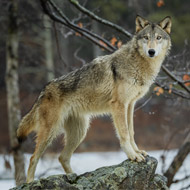
Scientists compare skull scans of wolves, hyenas and lions
A study involving the analysis of skulls of wolves, hyenas and lions has identified how the world’s first dogs hunted 40 million years ago.
The method of pouncing on prey, as observed in foxes and coyotes today, can be traced back to Hesperocyon gregarius – the first known species of dog.
It was also discovered that Epicyon haydeni – the largest species of dog ever to live – also hunted in a similar way. The animals could reach the size of a grizzly bear.
Computerised scans of modern animals and fossils were used by experts at the University of Edinburgh and the University of Vienna to produce digital models of the inner ears of 36 types of carnivoran.
The digital models included those of six extinct species.
Results revealed how the size of three bony canals in the inner ear evolved over millions of years as different hunting styles were adopted by the animals.
Larger ear canals evolved in faster predators such as wolves, lions and cheetahs. The researchers believe that this enabled the animals to keep a stable head and vision while hunting at speed.
The researchers also discovered how inner ear structures can reveal if a species descended from dog-like animals or to one of four animal families resembling cats. In particular, dog-like animals have a larger angle between two parts of the inner ear.
Julia Schwab, a PhD student at the University of Edinburgh, conducted the original research which inspired the study.
Commenting on the latest study, Ms Schwab said: “For me, the inner ear is the most interesting organ in the body, as it offers amazing insights into ancient animals and how they lived.
“The first dog and the largest-ever dog are such fascinating specimens to study, as nothing like them exists in the world today.”
The study is published in the journal Scientific Reports.



 The RCVS has announced a new version of its 1CPD mobile app, with enhanced features for veterinary surgeons and veterinary nurses to record their continuing professional development.
The RCVS has announced a new version of its 1CPD mobile app, with enhanced features for veterinary surgeons and veterinary nurses to record their continuing professional development.